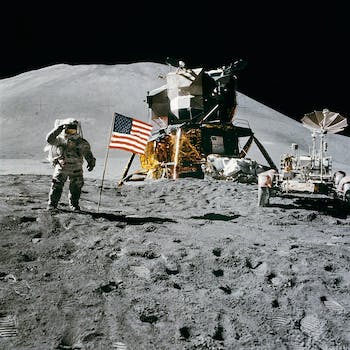-
Table of Contents
“Discover the infinite wonders beyond our world.”
Introduction
Exploring the Vastness: Journeying into Outer Space
Outer space has always captivated the human imagination, offering a realm of endless possibilities and mysteries waiting to be unraveled. The exploration of outer space has been a remarkable endeavor, pushing the boundaries of human knowledge and technological advancements. From the first manned missions to the moon to the ongoing exploration of Mars and beyond, humanity’s journey into outer space continues to inspire awe and wonder. In this article, we will delve into the vastness of outer space, exploring the challenges, discoveries, and potential future of space exploration.
The Wonders of the Universe: A Guide to Exploring Outer Space
Exploring the Vastness: Journeying into Outer Space
The wonders of the universe have captivated humanity for centuries. From the ancient civilizations who gazed at the stars in awe to the modern-day space explorers, the desire to understand and explore outer space has been a driving force in our quest for knowledge. In this guide, we will delve into the mysteries of the universe and explore the various ways in which we can journey into outer space.
One of the most common ways to explore outer space is through telescopes. These powerful instruments allow us to observe distant celestial objects and gain a deeper understanding of the universe. With the advancement of technology, telescopes have become more sophisticated, enabling us to see further and with greater clarity. From the Hubble Space Telescope, which has provided breathtaking images of distant galaxies, to ground-based telescopes that allow us to study exoplanets, telescopes have revolutionized our understanding of the cosmos.
However, telescopes can only take us so far. To truly experience outer space, humans have ventured beyond the confines of our planet. The first step in this journey was the launch of the Soviet satellite Sputnik 1 in 1957, marking the beginning of the Space Age. Since then, numerous manned missions have been undertaken, with astronauts venturing into space to conduct research, repair satellites, and even live on the International Space Station.
The International Space Station (ISS) is a marvel of human engineering and collaboration. It serves as a research laboratory and living space for astronauts from various countries. The ISS orbits the Earth at an altitude of approximately 400 kilometers, allowing astronauts to experience microgravity and conduct experiments that would not be possible on Earth. The ISS has been instrumental in advancing our understanding of the effects of long-duration space travel on the human body and has paved the way for future missions to Mars and beyond.
In addition to the ISS, there have been several missions to other celestial bodies in our solar system. The Apollo missions, which took place between 1969 and 1972, saw astronauts land on the moon and collect valuable samples. These missions provided valuable insights into the moon’s geology and helped us understand the formation of our solar system. More recently, robotic missions such as the Mars rovers have explored the red planet, searching for signs of past or present life.
Looking ahead, the future of space exploration holds even more exciting possibilities. Private companies such as SpaceX and Blue Origin are working towards making space travel more accessible and affordable. They are developing reusable rockets and spacecraft that could potentially take tourists to space and open up new opportunities for scientific research. Furthermore, plans are underway for manned missions to Mars, with the goal of establishing a permanent human presence on the red planet.
In conclusion, the wonders of the universe continue to inspire us to explore outer space. Through telescopes, manned missions, and robotic explorers, we have made significant strides in our understanding of the cosmos. The International Space Station has provided a platform for scientific research and collaboration, while private companies are pushing the boundaries of space travel. As we journey further into outer space, the mysteries of the universe await us, and the possibilities for discovery are endless.
Unveiling the Mysteries: Discovering the Secrets of the Cosmos

Exploring the Vastness: Journeying into Outer Space
Unveiling the Mysteries: Discovering the Secrets of the Cosmos
The vastness of outer space has always captivated the human imagination. From the twinkling stars that dot the night sky to the awe-inspiring galaxies that stretch across the universe, the mysteries of the cosmos have beckoned us to embark on a journey of exploration and discovery.
As we venture into the depths of outer space, we are confronted with a multitude of questions. What lies beyond our solar system? Are there other habitable planets? How did the universe come into existence? These questions have fueled our curiosity and propelled us to develop advanced technologies that allow us to probe the secrets of the cosmos.
One of the most remarkable achievements in our quest to understand the universe is the Hubble Space Telescope. Launched into orbit in 1990, the Hubble has provided us with breathtaking images of distant galaxies, nebulae, and other celestial objects. Its observations have revolutionized our understanding of the cosmos, revealing the vastness and complexity of the universe.
Through the Hubble’s lens, we have witnessed the birth and death of stars, the collision of galaxies, and the formation of planetary systems. These observations have not only expanded our knowledge but have also sparked new questions about the nature of the universe. How do stars form? What triggers the explosive death of massive stars? How do galaxies evolve over time? The Hubble has given us a glimpse into the dynamic and ever-changing nature of the cosmos.
In addition to the Hubble, other space missions have contributed to our understanding of the universe. The Kepler Space Telescope, for instance, has been instrumental in the search for exoplanets – planets that orbit stars outside our solar system. By monitoring the brightness of distant stars, Kepler has identified thousands of exoplanets, some of which may have the potential to support life. These discoveries have ignited our imagination and fueled the search for extraterrestrial life.
Furthermore, the recent advancements in space exploration have allowed us to send robotic missions to other celestial bodies within our solar system. The Mars rovers, for example, have provided us with valuable insights into the geology and climate of the Red Planet. These missions have not only expanded our knowledge of our neighboring planets but have also paved the way for future human exploration of Mars and beyond.
As we continue to explore the vastness of outer space, we are confronted with the realization that there is still so much we do not know. The mysteries of the cosmos are far from being unraveled, and each new discovery only leads to more questions. However, it is precisely this sense of wonder and curiosity that drives us to push the boundaries of our knowledge and explore the unknown.
In conclusion, our journey into outer space has been a remarkable one. Through the Hubble Space Telescope, the Kepler Space Telescope, and other space missions, we have unveiled the mysteries of the cosmos and discovered the secrets of the universe. Yet, with each new discovery, we are reminded of the vastness and complexity that lies beyond our reach. The exploration of outer space is an ongoing endeavor, one that will continue to captivate our imagination and push the boundaries of human knowledge.
Beyond Earth: The Thrilling Adventures of Space Exploration
Exploring the Vastness: Journeying into Outer Space
Beyond Earth: The Thrilling Adventures of Space Exploration
The vastness of outer space has always captivated the human imagination. From the earliest civilizations to modern-day scientists, the desire to explore the unknown has driven us to venture beyond the confines of our planet. Space exploration, with its thrilling adventures and groundbreaking discoveries, has opened up a whole new world of possibilities.
One of the most significant milestones in space exploration was the launch of the Soviet satellite Sputnik 1 in 1957. This historic event marked the beginning of the Space Age and ignited a fierce competition between the United States and the Soviet Union, known as the Space Race. Over the next few decades, both nations would send numerous missions into space, each one pushing the boundaries of human knowledge and technological capabilities.
One of the most iconic moments in space exploration came in 1969 when Neil Armstrong became the first person to set foot on the moon. The Apollo 11 mission was a triumph of human ingenuity and determination, showcasing the incredible potential of space exploration. Since then, numerous missions have been launched to the moon, furthering our understanding of its geology and potential for future colonization.
While the moon has been a focal point of space exploration, it is just the tip of the iceberg. The vastness of outer space offers countless other celestial bodies to explore. Mars, often referred to as the “Red Planet,” has been a subject of fascination for scientists and space enthusiasts alike. Multiple missions have been sent to Mars, including the ongoing Mars Rover missions, which have provided valuable insights into the planet’s geology and potential for sustaining life.
Beyond our own solar system, the search for extraterrestrial life has become a driving force in space exploration. The discovery of exoplanets, planets orbiting stars outside our solar system, has opened up new possibilities for finding habitable environments. The Kepler Space Telescope, launched in 2009, has been instrumental in identifying thousands of exoplanets, some of which may have conditions suitable for life as we know it.
Space exploration is not without its risks and challenges. Astronauts face numerous physical and psychological challenges during their missions, including exposure to radiation, isolation, and the effects of microgravity on the human body. However, these challenges have not deterred scientists and explorers from pushing the boundaries of what is possible.
The International Space Station (ISS) has been a crucial platform for conducting research and testing technologies for long-duration space travel. Astronauts from various nations have lived and worked on the ISS, conducting experiments in physics, biology, and human physiology. This research is essential for future missions to Mars and beyond, as it helps scientists understand the effects of space travel on the human body and develop countermeasures to mitigate these risks.
As we continue to explore the vastness of outer space, the possibilities for new discoveries and advancements are endless. From the search for extraterrestrial life to the colonization of other planets, space exploration holds the key to our future as a species. It is a testament to our insatiable curiosity and our desire to push the boundaries of what is possible.
In conclusion, space exploration has taken us on thrilling adventures beyond Earth, from the moon to Mars and beyond. It has allowed us to glimpse the wonders of the universe and expand our understanding of the cosmos. As we continue to journey into outer space, we are poised to make even more groundbreaking discoveries that will shape the future of humanity. The vastness of space beckons us, and it is up to us to answer the call.
Q&A
1. What is outer space?
Outer space refers to the vast expanse that exists beyond Earth’s atmosphere, where celestial bodies such as stars, planets, and galaxies are located.
2. How do scientists explore outer space?
Scientists explore outer space through various methods, including telescopes, space probes, and manned missions. Telescopes allow for observations from Earth, while space probes and manned missions enable direct exploration and data collection.
3. What are the benefits of exploring outer space?
Exploring outer space provides numerous benefits, including expanding our knowledge of the universe, advancing scientific understanding, technological advancements, and potential discoveries that could impact various fields such as medicine, energy, and communication.
Conclusion
In conclusion, exploring the vastness of outer space is a remarkable and awe-inspiring journey. It offers us the opportunity to expand our knowledge, push the boundaries of human exploration, and gain a deeper understanding of the universe we inhabit. As we continue to venture into the unknown, we uncover new discoveries, unravel mysteries, and pave the way for future generations to explore and appreciate the wonders of outer space.

